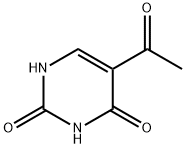Uses
5-Acetyluracil, a uracil derivative, can be used as a ligand for supramolecular aggregates, which not only allows the construction of two-dimensional porous lamellar nanostructures, but also introduces abundant nitrogen and oxygen defects. These defects can effectively modulate the electronic structure of carbon nitride, thus improving the separation of photogenerated carriers. In addition, the introduction of uracil derivatives also affects the energy band structure of the catalyst, which are important factors affecting the catalytic activity. Compared with the bulk carbon nitride, the photocatalytic carbon dioxide reduction activity of the synthesised materials was significantly enhanced under mild conditions, with carbon dioxide yields of 10.34, 28.65, 32.28 and 36.48 μmol g-1h-1 for BCN, CNU2.5, CNF2.5 and CNY2.5, respectively
[1].
Synthesis
5-Acetyluridine has been obtained by condensing the trimethylsilyl derivative of 5-acetyluracil with 2,3,5-tri-O-benzoylribofuranosyl chloride and removing the blocking groups with sodium methoxide
[2].
References
[1] SI LI . Uracil derivative-assisted universal synthesis of defective 2-dimensional porous flaky carbon nitride for efficient photocatalytic CO2 reduction[J]. Applied Surface Science, 2023. DOI:10.1016/j.apsusc.2023.158009.
[2] A.S. JONES ? R. T W G P Stephenson. Ribonucleosides and ribonucleotides derived from 5-acetyluracil[J]. Tetrahedron, 1979. DOI:10.1016/S0040-4020(01)93733-0.



